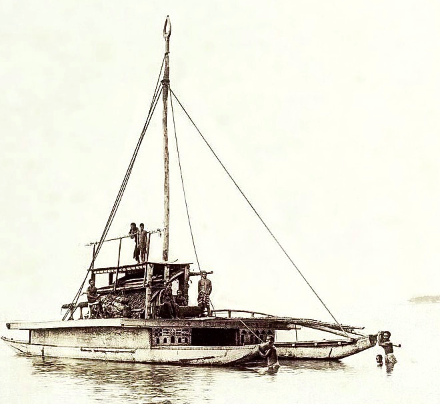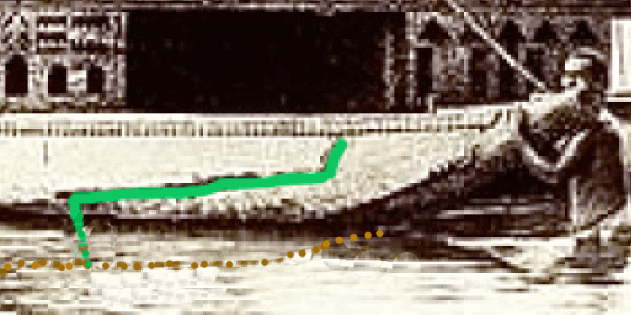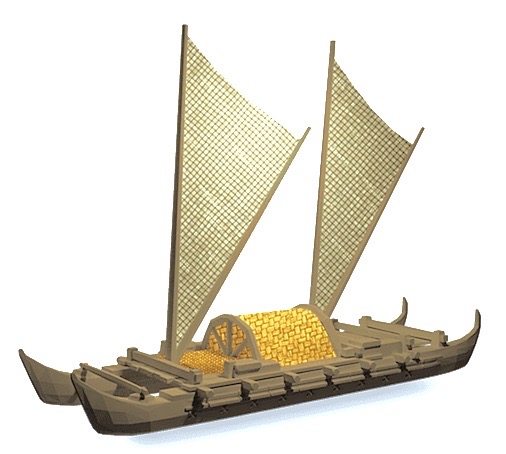|
'Whakataka'
is
a
modification of the final stanza of 'Tua,
Tua,' a longer karakia telling how the
waka Takitimu survived a storm when
exploring the coast of South Westland because it
was well-built and well-managed.
It reminds us that the great natural forces can harm
us, but if we work hard preparing for them, and then
respond in harmony with them and in harmony with our
ancestors' response, we are rewarded with warmth and
calm, both literally and spiritually.
In
2005,
Takirau Hohua (Tainui) turned this into a waiata
that is now
often sung in schools at the beginning of the day's
work.
Three sections of a karakiaThe
first section of a karakia usually acknowledges
the great forces that are at work connecting us to the
atua, the ancestral spiritual powers. Whakataka
can mean both 'prepare for' and 'make a change in
direction.' Lost in translationSome people appear not to have understood the karakia's triple structure when they tried to put this karakia into English. They
noticed that it was a "prayer" of sailors threatened
by a storm, and they then distorted the Maori words to
make all three sections requests for what is wanted. "May the winds from the west and south cease (?). There
are cut-and-paste copies of this very loose
translation on dozens of websites, including those of
NZ universities.
Ancient karakia seem to have been rational mental exercises to reassure those about to undertake a potentially hazardous event. "There
was a really big swell out on Manakau Harbour,
but Koro had a big launch and was wearing a lifejacket, (just like us) and he got back safely with lots of fish." (so we should all be OK too). Then unfounded belief set in. "If I recite that story of Koro's Manakau Harbour fishing trip in perfect detail, we will be safe and bring back lots of fish." (even in this old runabout) In recent times, Pakeha influences have distorted some 'karakia' into irrational requests. "Dear Lord, it is really rough out on Manakau Harbour, and we only have a flat-bottomed dingy and no lifejackets. Please help us get back safely with lots of fish, just like Koro did." Tua Tua Koi Rangi nuiThe original South Island story
Ko
Nga Moteatea (1858)
This
recalls how
the Takitimu, after sailing
from Rangiatea to the North Island,
was next used to explore South Westland.
When it ran into a cold front (strong
nor-westerlies, a cold southerly and then calm
sunny weather) near Franz Josef glacier and
Mt Cook, the Takitimu's four "taniwha,"
enabled the vessel to cut through the waves and
survive the storm. The high bow-posts and
stern-posts had been carved out by a huge adze and
attached to the hull in a complex, very strong,
manner, as shown in this 1905 photo of an old
Fijian-style Drua.
 
Punganangana
A condensed version from the Waikato
|
|||||||||||||||||||||||||||||||||||||||||
|
1st.
Acknowledging the great forces connecting us
to the spiritual powers and to the deeds of our ancestors. |
|
|
Punganangana
ki tawhito o te rangi tu nei. He ngana riri, He ngana taua. Ue-ue Papatuanuku; Ue-ue Ranginui; Te tungia te kawaru ra; Ko te hau tonga ka hara mai ra; |
This
storm is twice
as relentless as the ancient storms in the sky that used to rise up here, It has an angry relentlessness a warlike relentlessness. The Earth shakes. The Heavens shake. The tempest is withstood (?) as the southerly pushes rudely in. |
|
2nd. Loosening
the harmful bonds and strengthening the
helpful ones. |
|
|
Toki nui te
toki,
Toki roa te toki, Toki tawahi e Ka whanatu au ka hahau i te takapu O te rangi e riri mai ana, E nguha mai ana, Ka hinga Ka mate. |
But
huge is
the legendary
adze long-lasting is the adze from Hawaiki is the adze! I go away to chop at the calf muscle of the always-angry sky, and keep fighting fiercely. It is defeated. It dies. |
| 3rd. Naming what is required for oneness with the forces and ancestors. | |
|
Whakataka to
hau ki te muri,
Whakataka to1 hau ki te tonga, Kia makinakina i uta, Kia makinakina i tai, Kia ao ake te ra, He tio, he keo, He hauhunga |
The
wind
circles,
settles
to
the north, then turns to the south and settles down until it is prickly cold inland and prickly cold at sea. So that the sun rises on a world of ice, snowy peaks and frost. |
|
1.
t
 (verb) to be tranquil, peaceful, settling
down.
(verb) to be tranquil, peaceful, settling
down. This is in Pei Jones version. Corrections I have
corrected a couple of typos that were in the
1864 text,
ka
haramai nei
(to come
here)
toki ta wahie (adze chops firewood) and also in the text used by Pei Jones in his 1950 manuscript.
ka mara mai nei
(to ferment here)
toki ta Wahie (adze chops Wahie) I have substituted phrases from the better-edited 1858 version.
ka hara mai
nei
(to
violate)
toki tawahi e (adze from overseas, ie Hawaiki) |
|
Karakia
Karakia are the chants of Maori ritual, using traditional language, symbols and structures. They are a means of achieving oneness - one with the atua, one with the ancestors and one with events of the past.
They have their own traditional structure, symbols and rituals, and their concern is the whole of the universe, earth, sea and sky and into the night.
Karakia are not magic spells depending on the exact recitation of the words. The words can be, and are, changed. The power of the karakia came from the atua, and the effectiveness of the karakia depended on the faith of the people using the chants.
Musical style
In
their use of ready-made phrases or formulas,
the karakia are similar to the other forms of
Maori recited chants and Maori songs. But a
traditional karakia was different in its
musical style - a very rapid monotone chant.
Today it is chanted more slowly, so the
listeners can understand it better.
Karakia were usually recited solo by males, though some of the work karakia have sections for a chorus and there are examples of Ngapuhi karakia recited by women.
Types of karakia
There were karakia for kumara growing, childbirth, warfare, sickness and death. Karakia for daily work, canoe building, good weather and protection against curses. Karakia to unite factions, to give power to weapons, to cure injuries, to ward off ill luck.
The earth, sea and sky, war and peace, life and death were all included, and the emphasis was on the human person. Every aspect of life was covered.
Michael Shirres
The above paragraphs are a summary of Karakia in Maori theology by Dominican priest Fr Michael Shirres PhD.
|
To
chant the words of the karakia
is to become one with the ancestors. We cut ourselves loose from what is destructive, and bind ourselves to what is life-giving. In the 'eternal present' of ritual, we become one with the whole movement of creation. |
MAORI MEMENTOS: a Series of Addresses, Presented to His Excellency Sir George Grey
| HE
POROPOROAKI KI A KAWANA KEREI NA NGA RANGATIRA O NGATI TIPA NA NGA KURA HOKI O TE MANIHERA. ......ta te Pakeha i tae tuatahi mai ki tenei motu he homai i nga tinaku pai ki a matou; kihai ano hoki ta nga Pakeha i muri iho i iti iho i tana. E tae koe ki to tatou Kuini, ki a Wikitoria, mau e ki atu, e whakapai ana matou nga tangata Maori, ki te whakahaere tika o ana Kawana e ngarea mai ana e ia ki tenei Motu. Kia whakaaro mai ano hoki koe ki enei tinaku kua oti nei te whakato e koe, ki enei wahi. Ekore ano matou nga tangata Maori o tenei awa e wareware wawe ki tau mahi. Rokohanga iho e koe e minamina kau ana o matou ngakau ki nga mahi a te Pakeha. Haere rawa ake koe, kua kake matou, kua mohio ki te parau, kua maha o matou huri kua tini o matou taonga, a, e whakaakona ana a matou tamariki ki nga Kura i whakatupuria nei e koe. Haere e Kawana Kerei! Hoki atu ki te whenua o au matua. Ma te Atua Nui koe e tiaki i a koe e rere ana i te moana nui. Ko to matou ano tena, he waiata na o matou tupuna:-- Whakataka to hau ki te Uru, Whakataka to hau ki te Tonga Kia makinakina i uta, Kia mataratara i tai, Kia ao rawa ake te ra. He tio. He keho. He hauhunga. Haere ki Ingarangi, PATOROMU, Me ara atu ewaru te kau ma wha. |
A FAREWELL TO
GOVERNOR GREY FROM THE CHIEFS OF NGATI TIPA
AND FROM THE SCHOLARS OF THE REV. MAUNSELL. ....the first Europeans who visited these islands gave us good seed; nor were the Europeans who came after them less good to us. When you go into the presence of Queen Victoria, say to her, that we Natives think highly of the adminis-trations of the Governors whom she has sent to these islands. And be you mindful also, in regard to the good you have planted in this land. We, the Natives of this River, will not soon forget your labours. When you first came, our hearts were desiring to learn the usages of the Europeans; and you leave us advanced as a people. We have learned how to plough; we have many mills, and much property; and our children are receiving instruction in the schools which you have established. Go, O Governor Grey! Return to the land of your fathers! And may the Almighty One preserve you while voyaging on the great sea. These are our sentiments, and this is a song of our forefathers:-- Come airs from the West, Where the purple-tint crest Of the cloud rises high o'er the strand; Or let the mild breeze From the cold Southern seas, Bring the frost and the ice on the land. Go to England. (Signed) PATOROMU, And eighty-four others. |
|
Note: The frost and the ice are seen only when the weather is extremely fine, and are experienced generally in New Zealand when the wind is from the South; hence the allusion. The West wind also ushers in fine weather; should breezes prevail therefore from either of these quarters, Sir George Grey's passage across the deep would be both safe and pleasurable.
Placed
on web May 13th, 2008
Adapted for small screens June 2021

Counter added 4 Mar 2024




